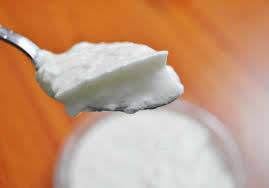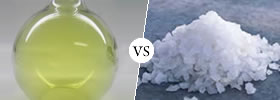Difference between Yoghurt and Curd
Key difference: Yoghurt and curd are two different types of dairy products. These two are two different forms of milk that are created by fermenting milk in some way. Yogurt is a diary product that is created by fermenting milk using bacteria. The bacteria that is used to ferment milk is known as ‘yogurt cultures’. Curd is a dairy product obtained by curdling with an edible acidic substance such as lemon juice or vinegar, and then draining off the liquid portion. However, in India the term curd is often used for yogurt/dahi.
 Yoghurt and curd are two different types of dairy products. These two are two different forms of milk that are created by fermenting milk in some way. Yoghurt and curd play an important part in cooking and diet in many different cultures around the world. These are completely different from each other in almost every aspect.
Yoghurt and curd are two different types of dairy products. These two are two different forms of milk that are created by fermenting milk in some way. Yoghurt and curd play an important part in cooking and diet in many different cultures around the world. These are completely different from each other in almost every aspect.
Yogurt is a diary product that is created by fermenting milk using bacteria. The bacteria that is used to ferment milk is known as ‘yogurt cultures’. The bacteria ferment the lactose in the milk causing it to produce lactic acid, which gives yogurt is tangy and acidic taste. Yogurt has been dated back to India and Iran circa 500 B.C. In India, yogurt and honey are known as "the food of the gods" and are a part of festivals and offerings. The word ‘yogurt’ is derived from the Turkish word, ‘yoğurt’, which means “to curdle or coagulated; to thicken” Yogurt is also spelled in various other ways such as yoghurt, yoghourt, yogourt, yaghourt, yahourth, yoghurd, joghourt, and jogourt.
Yogurt is most commonly created using cow’s milk; however it can also be created using water buffalo, goats, ewes, mares, camels, and yaks. In order to create yogurt, bacteria such as Lactobacillus delbrueckii subsp. bulgaricus and Streptococcus salivarius subsp. thermophilus bacteria culture are used. To create yogurt, the milk is first heated to about 80 °C in order to kill any additional bacteria that may be present and to denature milk proteins. The milk is then left to cool to around 45 °C, the bacteria is then added (when bacteria is not present, a spoonful of yogurt will also do the trick), the milk is then left to ferment at room temperature. The yogurt can be consumed raw, or flavored with sugar, salt, spices and any other flavors.
Yogurt is also very healthy as a part of daily diet. It is a good source of calcium, phosphorus, riboflavin-vitamin B2, iodine, vitamin B12, pantothenic acid-vitamin B5, zinc, potassium, protein and molybdenum. Yogurt is also high in probiotics that can help a person live longer. The bacteria can also help boost the immune system. People who have allergies to dairy products are advised to consume yogurt as it does not produce the allergy that is caused by lactose. Yogurt is also a good option for people who suffer from stomach ailments, such as diarrhea. Consumption of low-fat yogurt can also aid in weight loss.
Curds are another type of dairy product. Curds are made by curdling or coagulating the milk. This can be done by mixing edible acidic substances in to the milk, such as lemon juice or vinegar. Introducing these substance to the milk, will allow the milk to curdle and separate into two parts. The liquid part is the whey and the milk solids will be the curds. The whey contains the whey proteins of the milk, whereas the curds are the milk proteins or casein. Sometimes old milk might sour and separate without the added acidic substances.
Once the curds are separated, they may be eaten as is, or flavored with sugar, salt, spices and any other flavors, or it may be further processed into cottage cheese, quark and /or Indian paneer.
Curds can be made from cow, water buffalo, sheep/ewe, yak, reindeer, llama, camel, and goat's milk. A type of curd in Spain is made from ewe's milk.
Curd is nutritious. According to Livestrong, “Four ounces of fresh cottage cheese or curd contains: 111 calories; 13 g protein, 5 g fat and 3 g carbohydrate in the form of lactose. It also contains measurable amounts of vitamins A, E and K; thiamine, riboflavin, niacin, pantothenic acid, vitamin B6, folate and vitamin B12. It also contains calcium, iron, magnesium, phosphorus, potassium, sodium, zinc, copper, manganese, fluoride and selenium, as well as saturated fats, and oleic acid, which is a monounsaturated fat.” Curds also have a healthy content of probiotics.
However, some claim that curds have a high content of protein, which may acidity the blood. In order to nullify this acid, the body seeps calcium from the bones and releases it into the blood. Over time and excessive acid in the blood may increase chances of osteoporosis.
In South Asia, the term curd refers to yogurt. Sometimes the term may even refer to non dairy products that appear to have a texture similar to the dairy curd. These include curds made from soy milk, as well as curdled eggs, bean curds and lemon curds.
A detailed comparison of Yogurt and Curd:
|
|
Yogurt |
Curd |
|
Definition |
Yogurt is a dairy product that is created by bacterial fermentation of milk using ‘yogurt cultures’. The bacteria causes fermentation of lactose and produce lactic acid. |
Curd is a dairy product obtained by curdling with an edible acidic substance such as lemon juice or vinegar, and then draining off the liquid portion. |
|
Origin |
As far back as 2000 BCE |
Curd dates back millennia |
|
Produced from which milk |
Cow, water buffalo, goats, ewes, mares, camels, and yaks. |
Cow, water buffalo, sheep/ewe, yak, reindeer, llama, ewe, camel, and goat's milk. |
|
Making process |
The oldest dated records show yogurt being used in the ancient culture of India and Iran as far as 500 B.C. |
Probably first discovered accidentally as old milk curdled. |
|
Health benefits |
Yogurt is a good source of calcium, phosphorus, riboflavin-vitamin B2, iodine, vitamin B12, pantothenic acid-vitamin B5, zinc, potassium, protein and molybdenum. Yogurt is also high in probiotics that can help a person live longer. The bacteria can also help boost the immune system. |
Curd is nutritious. Four ounces of fresh cottage cheese or curd contains: 111 calories; 13 gram protein, 5 gram fat and 3 gram carbohydrates. Also contains amounts of vitamins A, E and K; thiamine, riboflavin, niacin, pantothenic acid, vitamin B6, folate, vitamin B12, calcium, iron, magnesium, phosphorus, potassium, sodium, zinc, copper, manganese, fluoride, selenium saturated fats, and oleic acid. Also high in probiotics. |
|
Taste |
The lactic acid produced by the ‘yogurt cultures’ bacteria might cause a tangy, acidic taste to the yogurt. |
Curd tastes slightly more tangy or sour than yogurt. May squeak against teeth while eating. |
|
Other uses |
Yogurt can be eaten just like that or it can be salted or sweetened. Additional flavors can also be added to the yogurt. Yogurt is also used as a replacement for heavy cream in many recipes. It is also useful in creating other beverages such as the Indian lassi or chaas. |
Curd can be eaten just like that or it can be salted or sweetened. It is most often used in desserts or served in sandwiches or salads. |
Image Courtesy: scdlifestyle.com, bigcheeseproject.wordpress.com









Comments
Jinane
Thu, 09/24/2015 - 19:43
To all the people that are commenting that the article is wrong, please read the article carefully. There are three different words mentioned that are constantly being confused - curd, yogurt and paneer. Curd has a different meaning in India and Pakistan, while it has a different meaning in the rest of the world. In India and Pakistan - curd means yogurt, while in the rest of the world it means the curdling of milk (by adding an acidic substance). The curd can then be used to make paneer by draining the water out from the curdled milk and hanging it to solidify. Now, yogurt is known as 'dahi' in India and Pakistan. So, stop saying the article is wrong, it is accurate!
Nikita
Tue, 07/21/2015 - 23:10
U want to say that curd & chenna is same..?
Anonymous
Sat, 07/11/2015 - 23:02
Actually yogurt is Indian dahi. Curd is a corrupt/wrong word for dahi/Thair(as it is in south India).Curd is a intermediary product obtained in the process of making cheese or paneer by curdling the milk and removing the whey. But here in India we prepare dahi same way as the preparation of yogurt mentioned in the article above. we do not add any edible acidic substances but add fermenting bacteria to the milk to kick start the process of fermentation and the end result will be dahi which is called yogurt in turkey and western countries, curd in India. That's all.
Shivaram
Fri, 07/10/2015 - 18:36
Curdling process described here will result in what is known as cottage cheese aka paneer. Curd is formed as a result of bacteria processing the milk called lactobacillus acidophilus. Get you research straight dude before blogging.
Jay
Wed, 06/24/2015 - 02:16
Dahi is yogurt and curd is paneer ,... Got that. .. thanks.
but what curdle is? curdle is verb (process of thicken.) it can be used for both yogurt and curd.
Gaurav Chawra (...
Wed, 06/10/2015 - 14:06
Cool
Avinash
Tue, 01/20/2015 - 18:02
Please do not get confused between 'Curd' and 'Paneer'.The 'Curd' usually called 'Dahi' in India needs starter culture and is incubated at specified temperature to settle or coagulate the milk . While 'Paneer' is usually made by coagulating the hot milk instantly by lemon or such sour material. And is also used to make popular 'Chchena' sweets in Bengal of India.
Further process of draining the liquid part of curd and keeping the coagulated part in muslin cloth (hanged)for few hours makes it 'Maska or plain yogurt and flavored sweetened Maska is called 'Shrikhand' or flavored yogurt in India
Arti
Mon, 01/19/2015 - 19:00
curd is not dahi though in India it is popularly called curd only
curd is produce of curdled milk
Likewise Chhenaa and paneer are different though the process is almost same... They differ in consistency... just like daliya , aantaa and maida are not same though the raw material and process are SIMILAR NOT SAME
Chhena is softer and more paste like as compared to paneer Furthermore Chhenaa is mostly from cow's milk whereas Paneer can be from any cattle milk
Anonymous
Thu, 07/16/2015 - 18:15
I agree Curd is Dahi, but do we hang curd and keeping the coagulated part in muslin cloth (hanged)for few hours ? Baat hajam nahi ho raha hai. Yoghurt R curd tofat ta ki?
S Chowdhury
Tue, 05/05/2015 - 16:20
Pages
Add new comment